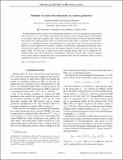Solutions to axion electrodynamics in various geometries
Author(s)
Bogorad, Zachary; Ouellet, Jonathan L; Bogorad, Zachary A.
DownloadPhysRevD.99.055010.pdf (896.2Kb)
PUBLISHER_CC
Publisher with Creative Commons License
Creative Commons Attribution
Terms of use
Metadata
Show full item recordAbstract
Recently there has been a surge of new experimental proposals to search for ultralight axion dark matter with axion mass, m_{a}≲1 μeV. Many of these proposals search for small oscillating magnetic fields induced in or around a large static magnetic field. Lately, there has been interest in alternate detection schemes which search for oscillating electric fields in a similar setup. In this paper, we explicitly solve Maxwell’s equations in a simplified geometry and demonstrate that in this mass range, the axion-induced electric fields are heavily suppressed by boundary conditions. Unfortunately, experimentally measuring axion-induced electric fields is not feasible in this mass regime using the currently proposed setups with static primary fields. We show that at larger axion masses, induced electric fields are not suppressed, but boundary effects may still be relevant for an experiment’s sensitivity. We then make a general argument about a generic detector configuration with a static magnetic field to show that the electric fields are always suppressed in the limit of large wavelength.
Date issued
2019-03Department
Massachusetts Institute of Technology. Department of Mathematics; Massachusetts Institute of Technology. Department of Physics; Massachusetts Institute of Technology. Laboratory for Nuclear ScienceJournal
Physical Review D
Publisher
American Physical Society
Citation
Ouellet, Jonathan and Zachary Bogorad. "Solutions to axion electrodynamics in various geometries." Physical Review D, 99, 055010 (2019)
Version: Final published version
ISSN
2470-0010
2470-0029